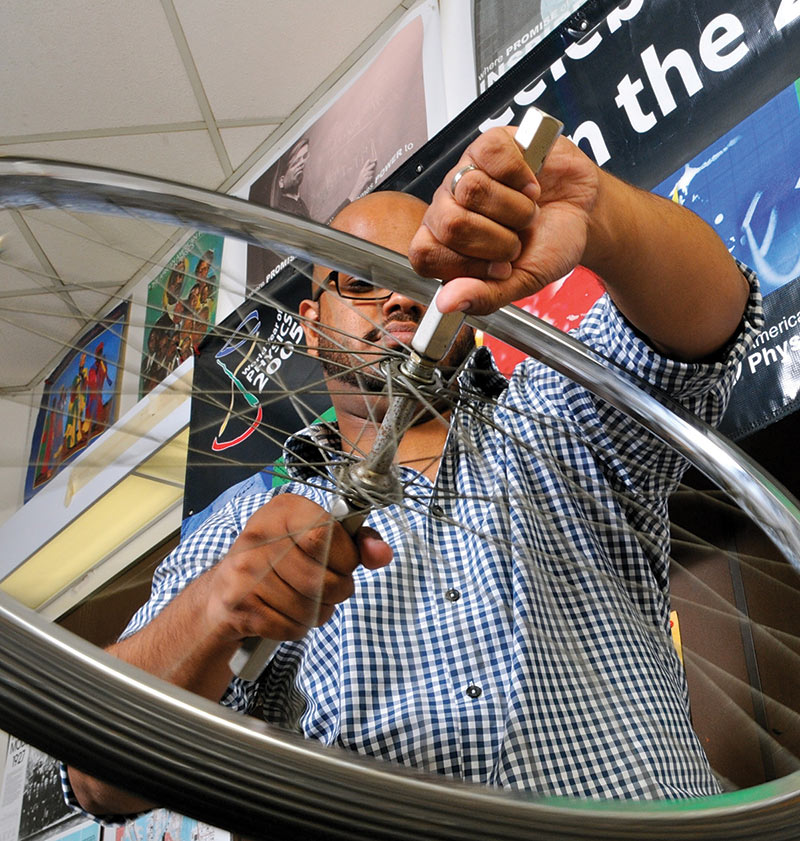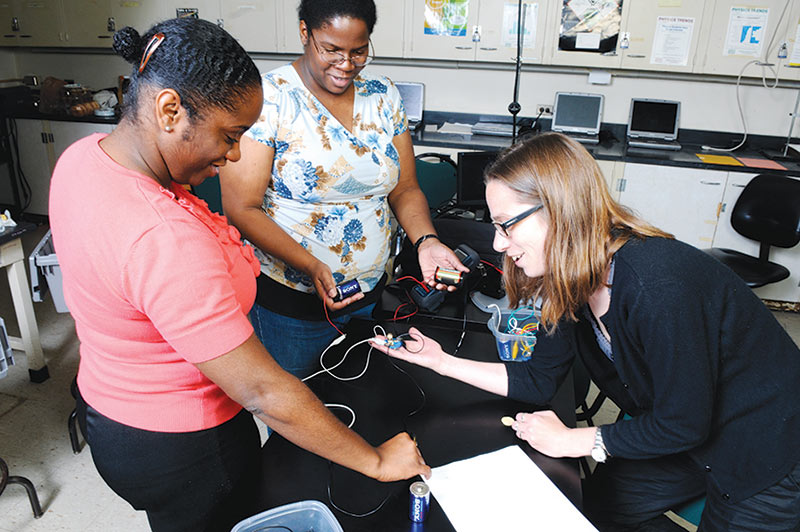Chicago State University: Equipping the Next Generation of Physicists
Fall
2019
Feature
Chicago State University: Equipping the Next Generation of Physicists
Kendra Redmond, Editor
Learning to solve Schrödinger’s equation and calculate the potential of a charged sphere are essential parts of an undergraduate physics education. But for the physics faculty at Chicago State University (CSU), imparting knowledge isn’t the end goal. The Department of Chemistry, Physics, and Engineering Studies has a larger aim—to prepare students to be competitive in a broad range of professional careers, including the health sciences, education, business, engineering, and research. In addition to high-quality teaching and engaging students in active learning, here are three ways the physics program prepares students for success:
1. Involving students in decision-making
At CSU, physics undergraduates have an important voice. They are real collaborators in the development of the physics program, says CSU physics professor Mel Sabella. For example, many undergraduates are peer instructors through the department’s highly successful Learning Assistants (LA) program. LAs facilitate group discussions and classroom engagement in both lower- and upper-division courses. Often, they help develop lessons, choose problems, and provide feedback to faculty about what’s working and what isn’t.
Highly engaged undergraduates are valuable to everyone, according to Sabella. The students gain leadership experience and a sense of ownership in the program. Furthermore, they start to develop a sense of themselves as science professionals capable of making meaningful contributions. “Involving [students] in leadership roles supports their development of science identity. This is especially important for students underrepresented in the STEM disciplines,” explains Sabella.
Meanwhile, the faculty benefits from student insight. Most of the physics undergraduates at CSU come from the South Side of Chicago, so student leaders are intimately familiar with the experiences, cultures, strengths, and challenges of their peers. This enables them to offer perspectives and expertise on the student experience that many faculty members don’t have.

2. Facilitating a diverse, supportive community
After a year at a different university and then a year off from school, Travante Thompson entered CSU juggling three jobs and a baby. “It just felt like home,” he recalls of the department. The active learning focus suited him, but looking back Thompson most appreciates how the faculty members really worked with him as an individual. He came to CSU intending to transfer after two years to a school with an ABET-accredited engineering department but decided to stay after falling in love with physics and experiencing the supportive environment. He graduated with a physics degree in 2018 and is now a beam operator at Fermi National Accelerator Laboratory.
That tight-knit community was the first thing Lionel Pittman noticed when he became a physics faculty member at CSU five years ago. “We know everyone in the department. We learn a lot about their livelihoods and what goes on in their lives,” he says. At times maintaining these personal connections requires a little extra investment, but it’s motivated by a strong desire to see every student succeed, says Pittman.
This strong sense of community isn’t an accident. It is fostered through classroom interactions, informal conversations, and organized department programs such as the LA program, a Society of Physics Students chapter, and a unique Chi Sci Scholars Program that supports cohorts of new chemistry and physics majors. One of the highlights of the scholars program is an off-campus retreat during which students and faculty cook meals together, talk, play games, and get to know each other. The department also works together each year on a program to support K–12 students, parents, and teachers in developing science fair project ideas.
“Building a community that trusts each other, that has strong relationships that aren’t just in the classroom… [these] are the really powerful things when you talk about engaging the next generation,” says Sabella.
3. Requiring research
All CSU physics majors do research. In fact, to earn a bachelor’s degree in chemistry or physics, students must complete a thesis based on at least 100 hours of directed, original research. The research can be conducted with a faculty member or as part of a summer program or internship, but it must be presented in written form and defended in front of a thesis committee.
A thesis requirement is unusual at the undergraduate level, in part because it requires a lot of faculty effort. However, the department deems it worthwhile because students develop so many important skills along the way. From communication to analysis and problem solving, these skills complement a traditional physics education and prepare students for the modern workforce.
Thompson spent two months at CERN in Switzerland during the summer of 2017 working on high-energy physics research with CSU professors Edmundo Garcia and Austin Harton. He also participated in a different kind of research during his senior year at CSU—a National Science Foundation–funded project to turn one of the CSU classrooms into an engineering lab space. Working with Pittman and Professor Archie Peters, Thompson led a small group of students in proposing a redesign for the space. Through these experiences he learned skills that are not typically taught in the classroom—presenting proposals to stakeholders, collaborative research, staying on budget—but are nevertheless key to successfully navigating a career. This is one of the things that makes CSU different from other departments, says Pittman. “[W]e are not only creating the next generation of physics graduates, but also people who are versed in research skills.”
Some might see these efforts as distractions that dilute the traditional physics education, but the program has a track record of success. CSU plays a national role in increasing diversity in physics, graduating high percentages of African American and female students. Physics bachelor’s degree recipients routinely go on to physics graduate programs, other STEM graduate programs, and STEM jobs. Many alumni stay connected to the department and return to give career talks to undergraduates. According to Thompson, it’s the place to go “if you want to go somewhere where the faculty will work their hardest to make sure that you learn the best way that you learn.”
The LA Program, Chi Sci Scholars Program, and the Laboratory Modernization Project are partially funded by grants from the National Science Foundation (DUE# 1524829, DUE# 1356523, DUE# 1712389) and the Department of Education.
Chicago State University At-a-Glance
Type of institution: Public
University enrollment: 2,964 (2018)
Student body: CSU is 69% Black and 68% female. Roughly one-third of the students are first-generation college students, one-third are traditional students, and one-third are nontraditional students.
Moving On & Looking Back
Felicia Davenport graduated from CSU last spring and is now pursuing a PhD in bioengineering at Georgia Tech. “I thoroughly enjoyed my time at CSU,” she reflects, attributing her positive experience in large part to the close-knit department and the supportive faculty. “I developed mutual feelings of respect and admiration for the faculty members that made me feel supported and safe within the department,” she says. She also credits the focus on “real world” skills for helping physics undergraduates turn into a team of collaborators. “[T]he students are eager to work together to help everyone achieve their own goals,” she says.



